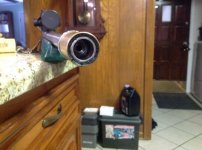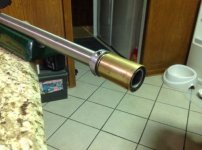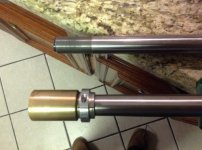Of course I will try to do better and thank you in advance. No arguing, just trying to get down to just a short clear expectation. You are doing fine work and I will print this and go shoot it very carefully.
Verify please we are talking about a 6ppc cartridge to begin with? Or 6 Beggs in Genes case.
It makes no difference what the cartridge is...but yes, as well as most any typical br cartridge, and a few others as well, in both long and short range guns. To say that one cartridge needs further tuner movement than another is saying that the natural frequency of vibration is different. I know of nothing based on science that would support that. Now, how often you may need to move it, based seemingly on the powder, may well be different. 133 seems to be an anomaly in this regard. I think it is so with or without a tuner, though.
When in tune and in a near nothing condition, my rifles will shoot very small, about .100 or about on the target and lets say the tuner is set to a mark of zero at that time. Later when I am fully out of tune the gun will shoot a large group of .380
That's a lot of difference..more than I've experienced attributable to conditions alone, but with a tuner. IME, the tuner is capable of taking the gun further out of tune than any non-wind condition. on the target and according to you and now Gene I only need to move the tuner about .004 from zero to make it really shoot bad. Is that a correct example?
The .004" is a real number that I have seen hold very near the same on most barrels with my tuner. But, barrel stiffness, tuner weight and location all matter in this regard and a blanket statement is not possible IMHO. My example of .004 was specifically related to a 24" HV contour barrel and MY tuner. The result I mentioned is very typical of the amount of tuner movement in a given condition to take said barrel from completely in tune, to completely out of tune. Likewise If I continue and move the tuner a total of .008
The .008" example is from node to node..not in tune to out of tune. the rifle will return to a small group, correct? Several guns, barrels and several powders you have tested have held closely to this amount of movement, Correct?
That's a fair statement. This has held pretty much true across a wide range of guns, barrels and calibers..but it is not meant to be specific to all guns, etc. Small differences should not be unexpected.
If correct I am very happy and just need to test my rifles, and barrels to come to a specific Span(node to node) for those lengths, weights etc., then tie it to a tracking method.
Secondly how do you track the change during the day, what measurements and tools?
I use to track by temps alone. I could do so with a fair degree of repeatability, if need be. It was done more to see if I could do it in a practical fashion without the need for an elaborate weather station, more than of necessity. As long as we have sighters, it's unnecessary information. It's simply so easy to shoot a group on the sighter target and make 1 or 2 adjustments if needed, before going to the record.
Have you seen a big impact after cleaning?
Me, clean?? LOL! Never paid it any attention. In theory, if you are getting any degree of compensation, it should make less difference than without a tuner. FWIW.
LOL! Never paid it any attention. In theory, if you are getting any degree of compensation, it should make less difference than without a tuner. FWIW.
Again thanks for enduring my poor writing and detail,
Stewart




